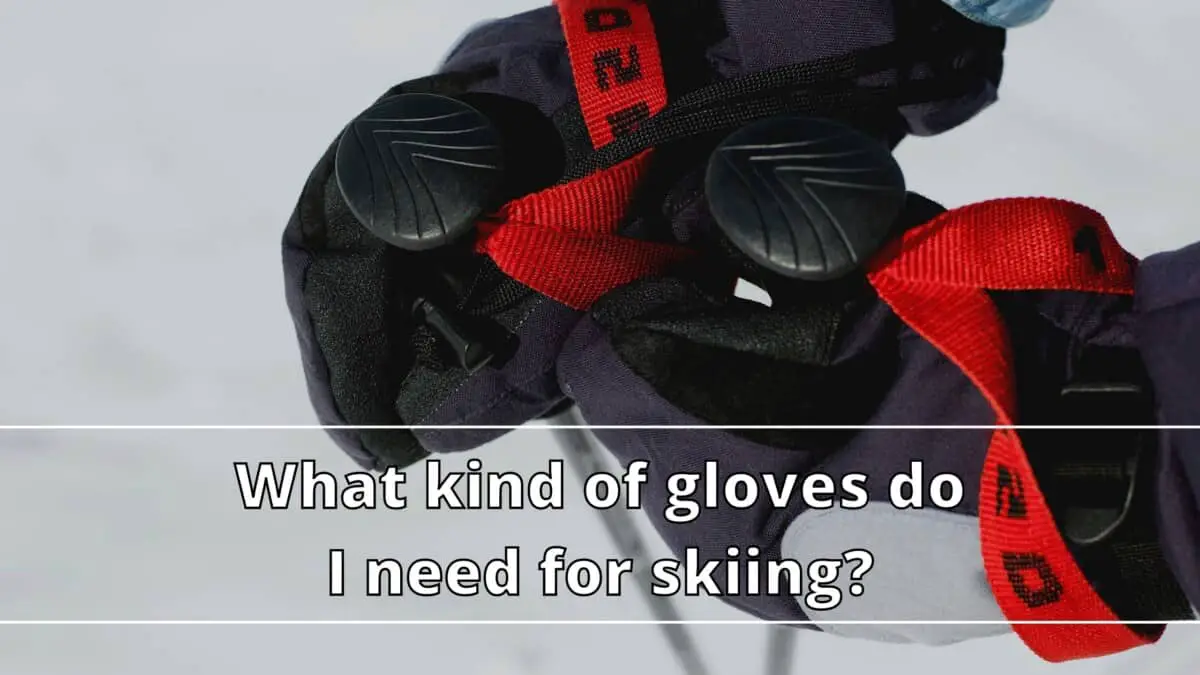Our hands are very vulnerable to frostbites. Thus, we must keep them warm by wearing gloves while skiing or engaging in any other winter activities.
But what kind of gloves do we need? How do we know they can withstand the elements?
The kind of gloves we need for skiing should be made particularly for the sport of skiing. In this way, we’ll know that it can hold against the weather elements. But, even if a manufacturer states that it is a ski glove, here are some guidelines to help you make sure that it can put up with the sport and weather.
Do you need special gloves for skiing?
It is wise to use gloves that are specifically or especially designed for skiing so you can get the most out of the activity. Therefore, when choosing gloves, it is important that you first determine what activity you need them for and make sure they provide the right materials and features.
To help you, here’s an overview of what skiing and snowboarding gloves are made of.
Skiing and snowboarding
Ski gloves and mittens for downhill ski and snowboarding are usually made of synthetic exterior or outer shell, often nylon with a combination of a waterproof and breathable barrier, plus some type of insulation to keep your hands warm in cold and wet conditions. These gloves also come with abrasion-resistant reinforcements on the knuckles, palms, and fingers to improve the overall durability of the gloves.
Cross-country skiing
Since cross-country skiing is a highly aerobic activity, cross-country ski gloves are made to be flexible and breathable to allow moisture from sweat to escape through the material more easily.
Once you know how you will be using the gloves, you need to remember the features you may need, like insulation, dexterity, waterproofness, touch-screen compatibility, and other extra features.
Skiing season is upon us! Whether you’re buying your very first ski gear or just looking to upgrade your old ones, we’ve got the top recommendations for you. Shop for the whole family and check out the best ski gloves for men, best ski gloves for women, and best ski gloves for kids. We have already chosen our top picks and it’s time for you to choose yours.
Do I need gloves or mittens?
Which one is better, gloves or mittens? To help you better understand what type of gloves you need for skiing, we’ve explained what features each type can provide and for what activities they are usually used.
-
Gloves
Gloves offer better dexterity than mittens as fingers are separated. They are ideal for when you need to handle gear frequently, zip jackets, adjust boot buckles, or hold multiple objects at the same time. Lightweight gloves are best used for cross-country skiing and other aerobic winter sports wherein your body generates more heat.
-
Mittens
Mittens offer more warmth than gloves as they keep your fingers together without any barrier, and thus, generate more heat. Although they cannot provide the same dexterity as gloves, they still allow you to hold your ski poles, hike in cold temperatures, and carve down the mountain on a snowboard.
-
Lobster
A lobster type of glove is a mix of a mitten and glove wherein your pinky, ring, and middle fingers are held together, and your index and thumb are each in separated fabric. They are great for activities that make you feel that your gloves aren’t warm enough and that your mittens hinder too much dexterity.
-
3-in-1
Some manufacturers also make 3-in-1 gloves consisting of a mitten and shell glove and a mitten or removable glove liner. These are versatile gloves that allow you to combine the shell and a liner for optimum warmth or to wear one individually in warmer weather. They also provide maximum dexterity for gear handling and can be purchased as a 3-in-1 glove or mitten system as a unit. Or, you can assemble your own by buying separate liners and shells.
Size and Fit
Whichever type of glove you prefer or need most, you need to make sure that it fits properly. This will ensure that your hands are warm and comfortable while maintaining your dexterity. Gloves that are too big will not keep your hands warm and will make it difficult for you to hold your ski poles and other gear and to perform tasks. And if they are too small, they can restrict movements and leave your skin or wrists exposed.
A properly fitting glove should have about ¼ inch of space at the end of outstretched fingers and, when making a fist, should neither feel too tight nor restrictive. Therefore, it is wise to measure your hand and check the manufacturer’s sizing chart to find the proper fit.
Do you need thick gloves for skiing?
You only need thick gloves for skiing if your hands get cold easily since thicker gloves mean more insulation. However, those may be heavy and bulky, which can hinder a wide range of movements, meaning you won’t be able to perform finer tasks than holding ski poles. Therefore, you need to choose gloves with proper insulation, which is catered to your type of skiing.
Insulation
Here are the two most common types of insulation used for ski gloves and mittens:
Down Insulation
Down is an excellent insulator and is praised for its breathability, easy compressibility, lightness, and durability. Although down insulation is more expensive than synthetic, it maintains its loft longer than synthetic, making it a good investment. Besides, down insulators can also lose their ability to insulate well when they get wet. Thus, they are not frequently used in gloves and mittens.
Therefore, when down insulation is used, it is often protected by waterproof shells that can help them stay dry, making them an excellent choice for skiing in cold and dry conditions.
Synthetic Insulation
This is a less expensive insulator that can even insulate when wet and dries a lot faster than down insulation. It is best for skiing, snowboarding, and playing in the snow, especially in locations with damp climates. The downsides are that they offer less warmth for their weight, are bulkier than down insulation, and that insulation decreases each time it gets compressed. Synthetic insulation is usually used in gloves for cross-country skiing, downhill skiing, and snowboarding.
Heated Gloves
These gloves feature battery-powered heating systems to boost warmth for freezing winter temperatures and anyone who easily gets cold hands. These gloves include rechargeable lithium-ion batteries and can operate on different levels of heat output. Since they operate with batteries and heating technology, they are heavier, slightly bulkier, and more expensive than non-heated gloves. However, if other gloves don’t work for you, these can be worth it.
If you’re looking for a glove made of durable material that has stood the test of time, why don’t you give leather gloves a try? They are warmer than other gloves and may be the most cost-effective material for ski gloves.
Touch-screen Compatibility
Manufacturers have now incorporated touch-screen compatible fingers and palms on some of their gloves and mittens to allow you to operate smartphones, cameras, or tablets without having to remove your gloves and expose your skin to the cold.
Touch-screen compatibility is usually found on light to mid-weight gloves that offer enough dexterity to allow you to control your gadgets. So, if you plan to use your gadgets frequently while out in the cold, it is wise to look for gloves with touch-screen compatibility.
Additional Features
-
Thumb Wipes
This feature consists of a soft material in the thumbs and is used specifically for wiping your nose.
-
Leather Palms
Gloves with leather palms will help you get an excellent grip and help the gloves withstand abrasion better than palms made of synthetic materials.
-
Zippered Pockets
This feature is often found at the back of the hand, can only fit disposable handwarmer packets, and can also be used as vents when it gets warmer.
-
Long Gauntlet Cuffs
Manufacturers also make some gloves extend up to your jacket sleeves. Pull them over your sleeves and cinch them close to keep the snow and cold air from getting in.
-
Leashes/Wrist Cords
Leashes will allow you to secure your gloves to your wrists to make sure you don’t drop them while on a chairlift or when you need to have a drink or snack.
-
Wrist Cinches
Wrist cinches are also added for gloves to have a snug fit at your wrist and to secure the gloves on your hands.
Once you’ve found the perfect pair of ski gloves, you need to maintain them and keep them clean so that they will last longer. If you’re not sure about how to clean your gloves, we have written an article about how to wash ski gloves that you can check out for information.
Which ski gloves do professionals use?
Professionals, including athletes, guides, rescue workers, and the military, use gloves that can withstand freezing temperatures and rugged use. This means the gloves should be rated high in essential metrics that include durability, dexterity, warmth, waterproofing, breathability, fit, and features. Although professional-grade ski gloves can be used for any winter activity as well as for rugged use, they may not be for everyone.
Therefore, it is still wise to choose a pair of ski gloves that can simply keep you warm, comfortable, and help you have a fun-filled day out in the snow without breaking the bank.
Conclusion
Not all gloves are created the same, but those you need for skiing should be made of a high-quality outer shell and an excellent insulator to withstand wet or dry winter conditions. The materials and features should be perfect for your skiing level and should be able to keep you warm and comfortable during a ski trip.
It is also better if the gloves are specifically made for skiing but still can be versatile enough for you to use them for any winter outdoor activities, even if that means shoveling snow in the driveway.

